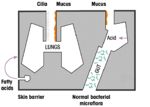Innate Immunity Barriers
Revision as of 15:51, 13 August 2010 by Bara (talk | contribs) (Created page with "===Physical Barriers=== thumb|right|150px|Epithelial Barriers - B. Catchpole, RVC 2008 '''''Skin''''' The simplest way to avoid infection is t...")
Physical Barriers
Skin
The simplest way to avoid infection is to prevent microorganisms gaining access to the body. The skin has an external coating of dead cells (cuticle) that, when intact, is impermeable to most infectious agents.
- Very few pathogens are capable of penetrating the thick stratified squamous epithelium of the skin (and lower urinary tract).
- Infection becomes a problem when there is:
- Skin loss: e.g. burns
- A break in the skin: e.g. wounds
- Infection becomes a problem when there is:
Mucus Membranes
- Thin epithelial surfaces are necessary for the normal physiological functions of the body's mucus membranes (ie absorption and gas exchange).They are therefore more susceptible to infection
- The body uses alternative protective mechanisms in these areas:
- The mucociliary escalator of the respiratory tract (assisted by coughing and sneezing)
- Peristalsis, vomiting & diarrhoea when necessary removes microorganisms from the GIT
- The body uses alternative protective mechanisms in these areas:
Biochemical Barriers
- Lactic and fatty acids in sweat and sebaceous secretions are directly bacteriocidal
- Enzymes e.g. lysozyme in saliva, sweat & tears and Gastric acid denature microorganisms
- Mucus itself is acidic, indigestible and traps microorganisms
Commensal Organisms
- Out-compete pathogens at mucosal and epithelial surfaces and produce natural antibiotics
- When commensals are disturbed, infection with opportunistic organisms is increased
- E.g. Candida (thrush) or Clostridium difficile (infectious diarrhoea)
